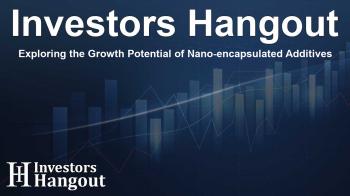Exploring the Growth Potential of Nano-encapsulated Additives

The Expanding Frontier of Nano-encapsulated Additives
The global landscape for nano-encapsulated additives is experiencing significant transformations, expected to reach a valuation of approximately US$ 10,090.2 million by the year 2034. Recent findings indicate a compound annual growth rate (CAGR) of 7.9%, showcasing a robust demand across a variety of sectors.
Driven by Technological Advancements
Nano-encapsulation technology is at the forefront, effectively protecting active ingredients from degradation while enhancing their performance across diverse applications. This is particularly crucial in industries like pharmaceuticals, food and beverages, agriculture, and coatings, where product longevity and effectiveness are key consumer demands. As businesses strive to innovate their product formulations, the appeal of nano-encapsulated additives continues to grow.
The Shift Towards Sustainability
The surge in market growth can be attributed to an increased emphasis on sustainable practices and the need for high-performance solutions. Businesses are looking to align their product offerings with consumer preferences for eco-friendly solutions. In this context, nano-encapsulated additives offer a cost-effective route to elevate product performance while adhering to sustainability goals.
Meeting the Diverse Needs of Industries
As various industries seek to adopt more advanced formulations, the use of nano-encapsulated additives is becoming favored for targeted applications. This trend is shifting manufacturers towards companies focusing on short-term projects rather than bulk traditional formulations. The flexibility and efficiency of nano-encapsulated solutions allow producers to meet specific project requirements effectively.
Key Market Insights
This sector is forecasted not only to maintain substantial growth but also to create increased opportunities for innovation. The global nano-encapsulated additives market has generated a lucrative opportunity valued at approximately US$ 1,463.8 million from 2019 to 2024.
Regional Market Dynamics
Prominent regions such as North America are expected to hold a significant market share, approximately 33.6%, by 2034. North America and East Asia are anticipated to create a collective market opportunity worth around US$ 2,975.2 million between 2024 and 2034, underscoring the critical nature of these markets in facilitating growth.
Segmentation by Additive Type
Within this burgeoning sector, liposomes stand out as a type of nano-encapsulated additive projected to grow at a CAGR of 8.4%, creating an absolute dollar opportunity estimated at US$ 1,403.7 million from 2024 to 2034. This segment is indicative of the shifting consumer preferences towards innovative and effective products.
Industry Leaders and Their Innovations
Several key players are making strides in the nano-encapsulated additives market. Companies such as Symrise AG, Balchem Corporation, FrieslandCampina Ingredients, and Aquanova AG, among others, are actively pursuing innovation. Their strategies include launching new products, forming partnerships, and expanding into new markets to harness growth potential and meet the evolving needs of consumers.
Emerging Developments
Notably, GF Fermentech has expanded its MediQ7 line of vitamin K2 components to include organic nano-encapsulated products, showcasing the trends of sustainability and health in product development. Such advancements not only enhance the efficacy and bioavailability of nutrients but also cater to the increasing consumer demand for high-quality health supplements.
The Future Ahead
The advancement of nanotechnology continues to boost the nano-encapsulated additives market, supported by rising investments in research and development. As consumers prioritise health and wellness, the demand for innovative, effective products with longer shelf-lives is escalating, particularly within food, pharmaceuticals, and cosmetic industries.
Driving Efficiency Across Sectors
The focus on enhancing product performance and durability drives the adoption of nano-encapsulated additives across various sectors. Companies are recognizing the importance of such technologies in maintaining competitive advantage and meeting consumer expectations for reliability and sustainability.
Frequently Asked Questions
What are nano-encapsulated additives?
Nano-encapsulated additives are materials that protect and enhance the performance of active compounds, commonly used in pharmaceuticals, food, and coatings.
How is the nano-encapsulated additives market projected to grow?
The market is expected to reach US$ 10,090.2 million by 2034, growing at a CAGR of 7.9%.
What industries are driving the demand for these additives?
Key industries include pharmaceuticals, food and beverages, agriculture, and coatings, all requiring advanced product formulations.
Who are the leading players in the market?
Prominent companies include Symrise AG, Balchem Corporation, FrieslandCampina Ingredients, and Aquanova AG, among others.
What are the benefits of using nano-encapsulated additives?
These additives offer improved stability, controlled release, and enhanced performance, making them valuable for product longevity and effectiveness.
About Investors Hangout
Investors Hangout is a leading online stock forum for financial discussion and learning, offering a wide range of free tools and resources. It draws in traders of all levels, who exchange market knowledge, investigate trading tactics, and keep an eye on industry developments in real time. Featuring financial articles, stock message boards, quotes, charts, company profiles, and live news updates. Through cooperative learning and a wealth of informational resources, it helps users from novices creating their first portfolios to experts honing their techniques. Join Investors Hangout today: https://investorshangout.com/
Disclaimer: The content of this article is solely for general informational purposes only; it does not represent legal, financial, or investment advice. Investors Hangout does not offer financial advice; the author is not a licensed financial advisor. Consult a qualified advisor before making any financial or investment decisions based on this article. The author's interpretation of publicly available data shapes the opinions presented here; as a result, they should not be taken as advice to purchase, sell, or hold any securities mentioned or any other investments. The author does not guarantee the accuracy, completeness, or timeliness of any material, providing it "as is." Information and market conditions may change; past performance is not indicative of future outcomes. If any of the material offered here is inaccurate, please contact us for corrections.
